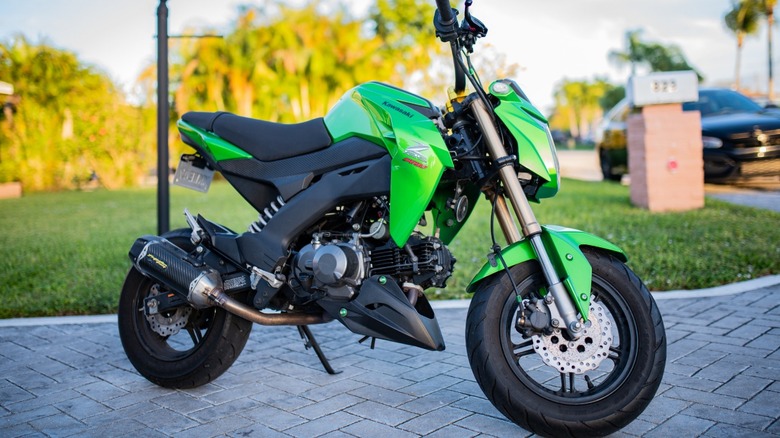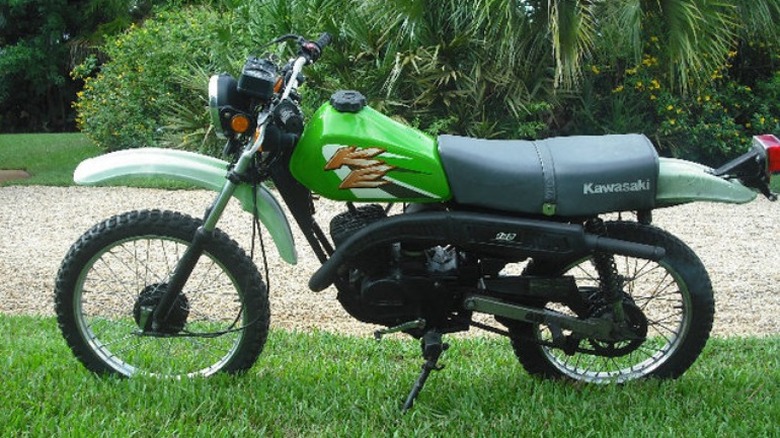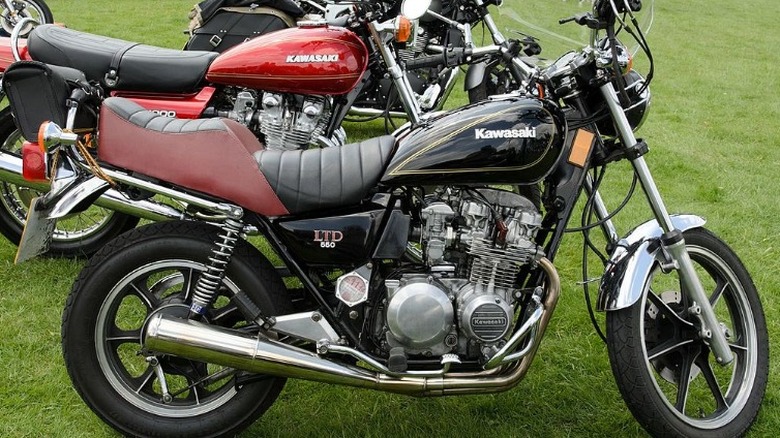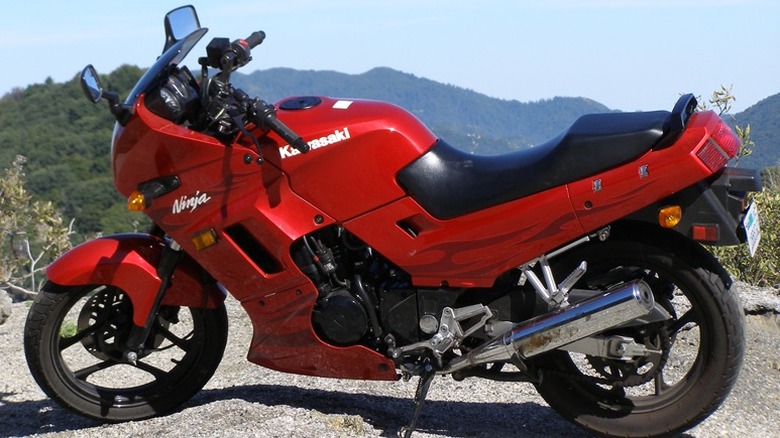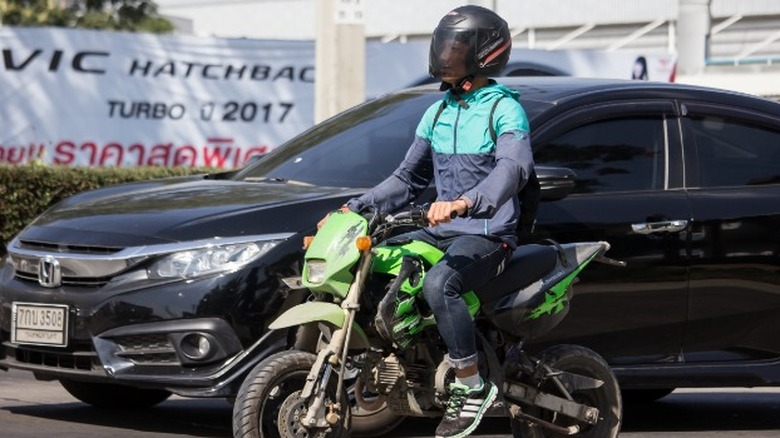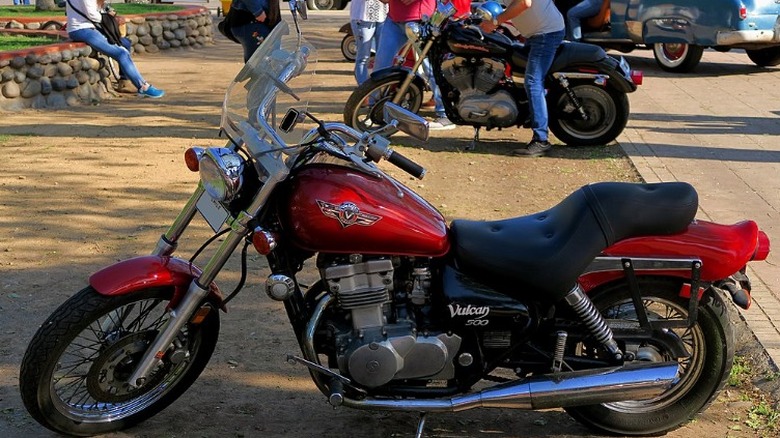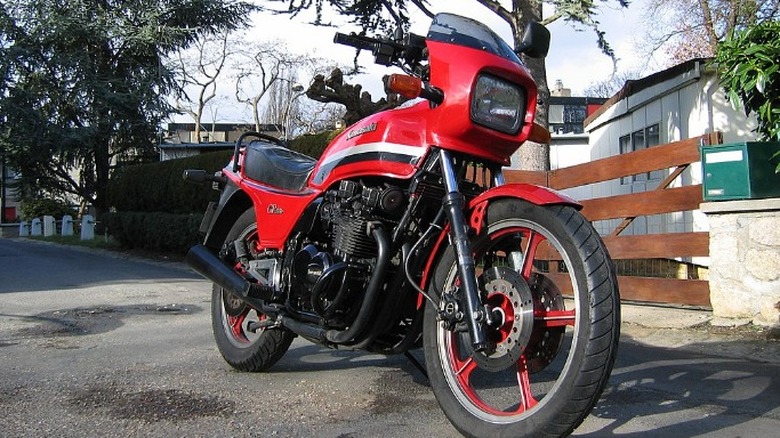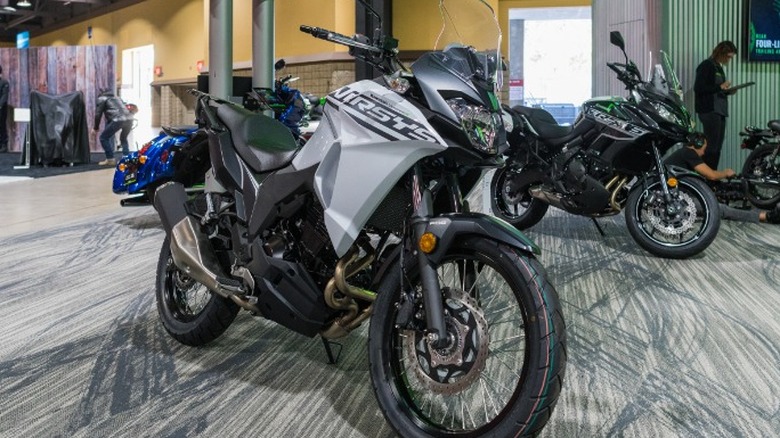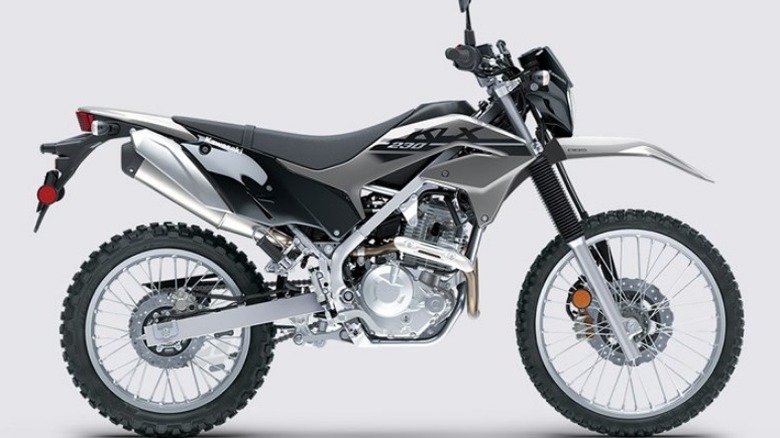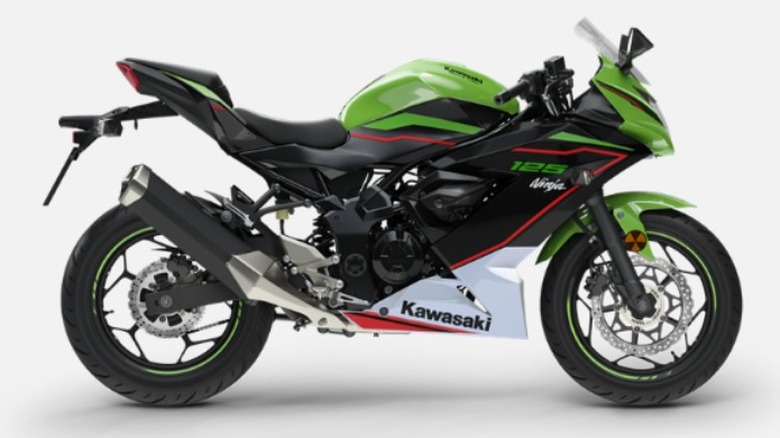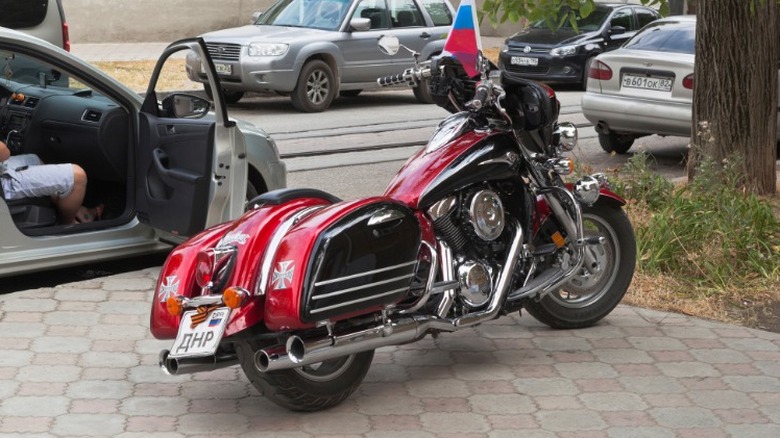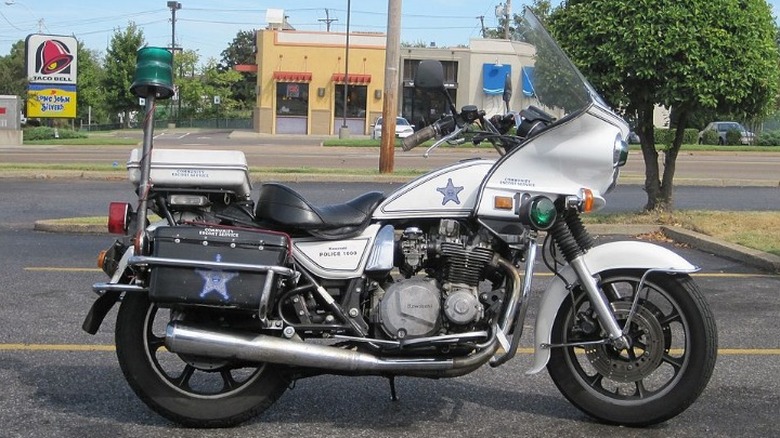10 Kawasaki Motorcycles You Can Likely Afford
Kawasaki Heavy Industries is one of Japan's largest industrial companies with a long history of manufacturing aircraft and heavy equipment. Since the late 1950s, motorcycles have been one part of its manufacturing base, proving to be popular consumer products. The first motorcycle from Kawasaki came in 1963 with the W1 based on the British BSA design (via Old Bike Barn). Since then, the company has continued to lead the field in making reliable motorcycles that excel in their purpose.
Some classic bikes such as the H1 Mach III, dubbed The Widowmaker, showed the world that Kawasaki was an innovative company fully capable of producing machines that did not just meet contemporary standards, but far exceed them. Its powerful line of two-stroke triples led to the KZ line of sport bikes that dominated the early '80s and later the unbeatable Ninja. Throughout the period, Kawasaki also made economy and entry-level bikes with the same high level of quality, introducing generations to two-wheel motoring. While an H2 Mach IV can set you back 40 large in today's market, other models are much more attainable. Therefore, considering only those machines that are legal for use on the street, here are 10 Kawasaki models you can likely afford.
Kawasaki KE100
For most kids growing up in the '80s or '90s, their first experience with motorized transport outside of Mom's station wagon was likely a Kawasaki KE100. It was the most basic full-size motorcycle around and it was dirt cheap. It featured a 100cc, two-stroke engine with not much power and even less style. However, it had a separate oil tank for mixing in the carburetor and a kick start, both of which meant it was easy to operate and would (almost) always start. The simple engine was easy to work on and parts were cheap if it ever needed any. The simplicity also translated into durability.
According to Revzilla, Kawasaki produced these basic little indestructible bikes from 1976 until 2001. By the time it ended production, it was already a relic. Top speed is about 50 mph on a good day and on a better day, the brakes will stop the bike. In almost every respect, it is a terrible motorcycle. However, it is also an excellent bike as it introduces people to riding and it can be ridden hard all day long and take every bit of the abuse, ready for another day. Most of these were basically destroyed by 14-year-olds well before they could get their first car, which could make finding them a bit on the tougher side. But, should you find one in the wild, it should be no problem to get it for around a thousand dollars. As long as you are not expecting too much from it, you will have a great buy.
[Featured image by Tommy Denham via Wikimedia Commons | Cropped and scaled | Public domain]
Kawasaki LTD550
Kawasaki introduced its KZ line of motorcycles in the late '70s, seeing much success with the likes of its KZ1000. In 1981, the LTD550 debuted, taking the bones and the heart of the KZ 550 and adding a distinct cruiser style more akin to a Harley-Davidson Sportster than most Japanese bikes of the era. It featured a wide saddle with raised passenger pillion, swept-back handlebars, and a more relaxed riding position. In a sense, the LTD550 merged the best characteristics of a Japanese sport bike with an American cruiser in a medium-sized package.
The LTD550, according to Motorcycle Specs, featured a 4-cylinder, air-cooled, 553cc engine that produced 58 horsepower. It used electric starting and chain drive, and it sent power through a six-speed transmission while stopping came from dual disc brakes up front and a drum out back. It is a competent and light bike with great handling for decent acceleration considering its size. Today they can be hard to find, but since it is not a particularly desirable model, bargains can be found. It makes a great step up for riders with some experience who aren't yet ready for a large and heavy motorcycle. Depending on condition, these can be picked up for between $1,500 to $2,000 today.
[Featured image by SG2012 via Wikimedia Commons | Cropped and scaled | CC BY 2.0]
Kawasaki Ninja 250
Ninja is one of the most recognizable names among sport bikes. Kawasaki has made a name for itself with its ultra-high-performance street machines known for high-revving engines and extreme acceleration. That said, the Ninja 250 does not fit that description, but it is a good bike for what it is. The Ninja 250 is mostly a basic bike with aggressive styling and solid durability.
Starting in the early '80s, Kawasaki began building and selling small versions of its sport bikes, originally for its home market only. It showed up in 1986 in North America where it proved to be a successful model, with the third generation beginning in 1988 being sold mostly unchanged until 2007. This bike has a parallel-twin engine that is water-cooled with dual camshafts and four valves per cylinder. With this arrangement, the engine is good for 37 horsepower, which will propel the bike to more than 100 mph (via 250ninja.net). This is usually reserved for a beginner bike that has plenty of power to get around, but won't be winning many races.
Scores of young riders have cut their teeth on a 250 before graduating to the much faster machines with larger engines. Because these bikes were affordable when new, Kawasaki sold a lot of them and that makes those that survived teenage motorcycle riding cheap to buy today. Later models can be found on Cycle Trader for $2,500, or, for not too much more, Kawasaki replaced this model with the current Ninja 300 for the U.S. market.
[Featured image by R Balciunas via Wikimedia Commons | Cropped and scaled | Public domain]
Kawasaki Z125 Pro
For many years, it was assumed that the American market had no room for small motorcycles. But in 2014, Honda brought us its diminutive 125cc GROM, and sales have gone gangbusters ever since. It appears that Kawasaki took notice and released its own small bike called the Z125 Pro. Similar to the GROM but with a larger footprint and more aggressive styling, the Z125 Pro looks like a seriously downsized supermoto, but in a good way.
The Kawasaki Z125 Pro has been around since 2019 and it features a 125cc, 4-stroke, air-cooled engine with four gears. It is a modern engine that uses fuel injection and makes 8.3 horsepower, which is good for about 64 mph, according to Top Speed. That means this is a good city cruiser and its size makes it easily managed in congested city centers, plus the excellent fuel mileage helps keep running costs low. The best feature of the little Z bike is that it is a blast to drive and its small wheels make it highly maneuverable. Best of all, brand new you can pick one up today for just over $3,000 from your local Kawasaki dealer.
Kawasaki Vulcan 500 LTD
Kawasaki introduced its Vulcan motorcycles to offer cruiser bikes in the style of the dominant American motorcycle style. It has since grown into a line of large touring bikes with impressive qualities and classic styling. However, the Vulcan name started with humble beginnings, and one of the models offered was more toward the beginner level with the Vulcan 500.
The Vulcan 500 LTD took over the medium size cruiser category and integrated much more decisive cruiser styling into the overall design. With a significantly laid-back riding position, tank-mounted gauge (on later models), and long raked forks, it looked every bit the Sporster clone in its day. The liquid-cooled, 2-cylinder engine is shared with the Ninja 500 and it provides ample power for a single rider, but may be sluggish with a passenger. Best Beginner Motorcycles praises the bike for its reliability and comfortable ride, suggesting it is an excellent choice for a first bike for fans of cruisers.
With a 20-year run ending in 2009, prices will vary significantly with at least a few bargains to be had. A search of Cycle Trader shows that $3,000 will buy one in great shape while bargains are available for less than $2,000 for earlier bikes.
[Featured image by RL GNZLZ via Wikimedia Commons | Cropped and scaled | CC BY 2.0]
Kawasaki GPZ550
One of the most popular bikes of the early '80s came from Kawasaki as a result of the success of another prior model, the KZ550. According to Cycle World, that bike was selling extremely well and dealers noticed owners modifying them in various ways for performance riding and racing. Kawasaki took note and made some changes to it and introduced the GPZ550, kicking off the sport bike era with this model.
The GPZ550 used the same engine as the KZ550 and LTD550, but with higher compression, larger camshafts, and revised ignition timing to eke out a bit more power and acceleration. As a result, Kawasaki could not make enough of them and these bikes dominated the middleweight class on the race track, per Motorcyclist. In contrast to previous models, this one was devoid of chrome in favor of all black on the engine and tailpipes and with a bright red tank and cafe fairing. It is a striking machine that remains popular as a classic cruiser.
With this kind of heritage, one might expect collectors to be buying them up and restoring them, yet many still remain in circulation. Perhaps because it was a good seller, inventories have not yet been exhausted. Listings shown on Smart Cycle Guide offer a price range of $2,00 to $4,000 for running examples with the nicest condition bikes topping out at a reasonable $5,000.
[Featured image by Gérard Delafond via Wikimedia Commons | Cropped and scaled | CC BY-SA 3.0]
Kawasaki Versys-X 300
The relative newcomer to the world of motorcycling is the adventure touring segment. Born out of a desire to take motorcycles on long stretches that include both pavement and dirt, riders wanted a machine that could handle both with competence. According to Motodreamer, the first bike purpose-built for this was the 1980 BMW R80 G/S, and the segment has grown consistently ever since. Kawasaki's current offering for the adventure tourer buyer is its Versys line, of which the Versys-X 300 is a part.
The Kawasaki Versys-X 300 is a good size bike with a tall ride height giving it clearance to tackle rough terrain. Its 300cc engine, which is fuel injected and water-cooled, provides just over 30 horsepower, making it strong enough to tackle terrain while maintaining good fuel economy. The six-speed transmission gives it tall gearing to keep up with traffic on long stretches of highway and the frame has room to stow gear for the road (via Motorcyclist).
For those wanting an affordable bike that is not restrained by concrete or asphalt, the Versys-X 300 is a good choice. It also happens to be one of the lowest-priced street bikes in the Kawasaki lineup at $5,899, although accessories for a tour can drive that up in a hurry.
Kawasaki KLX230
Before the adventure bike became a significant part of manufacturers' offerings, the dual-sport or enduro was a common sight in showrooms. These bikes are street-legal machines but have dirt bike bones all the way through. Dual-purpose origins stem from motorcycle makers adding lights and gauges to dirt bikes and installing tires suited for dirt but toned down to handle pavement. Many of these received 4-stroke engines in the early days until dedicated dual-sport bikes emerged from the factories and are now a standard part of any lineup.
Riders on a KLX230 will find this bike to be at home on the dirt, perfect for a day out on the trails with the ability to ride home instead of trailering it, although light commuting is not out of the question. The KLX can be used as an all-around bike, as the 230cc, 4-stroke engine provides an ample 17 horsepower to keep up with traffic, and its fuel-injected engine should prove to be as reliable as any street bike from the company (via Dirt Rider). Best of all, at $4,999, payments will leave plenty of money for riding gear for the dirt.
Kawasaki Ninja 125
As previously mentioned, Kawasaki has built part of its reputation on its excellent high-performance Ninja street bikes. Ninja bikes come in a range of sizes including the current 300cc entry-level bike, the discontinued 250cc, and the flagship ZX-10RR rocketship. However, for overseas customers, Kawasaki offers its Ninja sport bike in a 125cc model, the BX125.
In some jurisdictions, driver licenses are offered with differing classifications for motorcycles depending on engine size, and having a 50cc or 125cc motorcycle can be advantageous for licensing reasons. For example, U.K. licensing restricts many riders to 125cc or less, depending on the age and testing level of the licensee, according to Bike Social. Only after attaining the correct certification and reaching the age of 24 can one ride any size of motorcycle unrestricted. Therefore, 125cc sport bikes are still popular and most companies will capitalize on that.
Kawasaki offers its Ninja 125 with the same engine used on the Z125 Pro. Even so, it is a great-looking bike that mirrors the looks of the larger Ninja models. It comes with ABS standard along with fuel injection and a digital readout, making it feel like no less of a well-built Kawasaki motorcycle. Best of all is the price (via Motorcycle News). The Ninja 125 retail price is about $5,000.
Kawasaki Vulcan 1500
Kawasaki's Vulcan line proved to be a successful cruiser product that endures today. Kawasaki's biggest and most expensive products bear the Vulcan badge. The Vulcan line consists of a variety of bikes with various engine sizes, from 500 to the current 1,700, and the Vulcan 1500 had a good run from 1987 to 2008.
Kawasaki introduced the Vulcan line in 1985 with its 750cc cruiser. It brought distinctive cruiser styling to the market paired with Japanese reliability in a medium-sized package. With its success, Kawasaki just a couple of years later doubled the size of the engine with the Vulcan 1500 and further refined its styling to sit more in line with the American v-twin cruiser, and it did it rather well. Someone unfamiliar with motorcycles, in general, would likely have trouble differentiating between the American and the Asian bike. However, Harley-Davidson quality was in the dumps in the early '80s, and Kawasaki had always built stellar machines. The Vulcan 1500 took off and became one of the company's best sellers for years.
The Vulcan 1500 is a liquid-cooled bike with overhead cams, producing 65 horsepower and a healthy 85 pound-feet of torque. Big bikes are all about low-end pulling power, and the 1500 had it. With its five-speed transmission and shaft drive, per Big Bike Reviews, it is well suited for extended journeys of trouble-free riding. Today, these bikes are real bargains. While Harleys do hold their value and some continue to climb, Vulcans can be picked up for a song. Cycle Trader shows plenty of listings for early 2000s models, some fully dressed, for around $3,000.
Kawasaki KZ1000P Police
From 1982 to 2005, Kawasaki offered a version of its popular KZ1000 to police departments all over the country. For a time, it was ubiquitous on American streets and instantly recognizable to drivers everywhere. Its base was mostly the same as the consumer model but came with a broad, comfortable saddle for a single rider with an oversized fairing with special pods for red and blue lights, extra top and side cases for special gear, and a high-output alternator to run a radio and flashing lights.
The Police 1000, according to Bike Bound, used the same 90 horsepower air-cooled 1,000cc engine as the consumer model and was also equipped with special run-flat tires. The rider also had broad footboards instead of pegs and it came in a familiar black and white livery with black alloy wheels. These bikes were famously ridden by Jon and Ponch in the popular "CHiPs" television show about California Highway Patrol motorcycle officers.
While the Kawasaki Police 1000 patrol cycles have been retired long ago and replaced with a variety of Harley-Davidson, Honda, and BMW bikes — Kawasaki no longer offers police models — plenty are still around ready for civilian service. While classic KZ1000 models are continuing to climb in price these days, Smart Cycle Guide shows that you can get a nice running Police 1000 in most parts of the country for just a couple of thousand dollars, radar gun not included.
[Featured image by Thomas R Machnitzki via Wikimedia Commons | Cropped and scaled | CC BY-SA 3.0]
